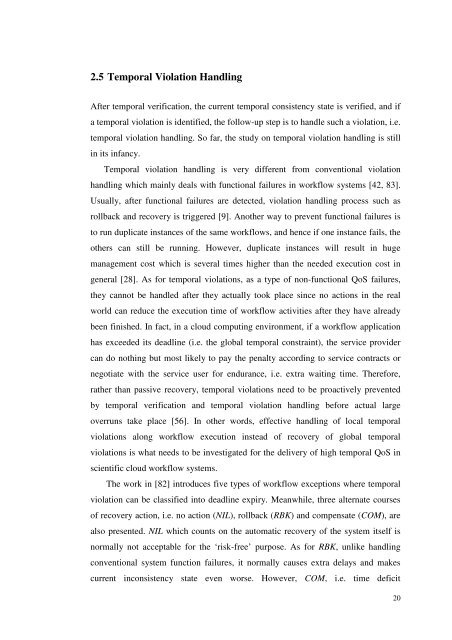Xiao Liu PhD Thesis.pdf - Faculty of Information and Communication ...
Xiao Liu PhD Thesis.pdf - Faculty of Information and Communication ...
Xiao Liu PhD Thesis.pdf - Faculty of Information and Communication ...
Create successful ePaper yourself
Turn your PDF publications into a flip-book with our unique Google optimized e-Paper software.
2.5 Temporal Violation H<strong>and</strong>ling<br />
After temporal verification, the current temporal consistency state is verified, <strong>and</strong> if<br />
a temporal violation is identified, the follow-up step is to h<strong>and</strong>le such a violation, i.e.<br />
temporal violation h<strong>and</strong>ling. So far, the study on temporal violation h<strong>and</strong>ling is still<br />
in its infancy.<br />
Temporal violation h<strong>and</strong>ling is very different from conventional violation<br />
h<strong>and</strong>ling which mainly deals with functional failures in workflow systems [42, 83].<br />
Usually, after functional failures are detected, violation h<strong>and</strong>ling process such as<br />
rollback <strong>and</strong> recovery is triggered [9]. Another way to prevent functional failures is<br />
to run duplicate instances <strong>of</strong> the same workflows, <strong>and</strong> hence if one instance fails, the<br />
others can still be running. However, duplicate instances will result in huge<br />
management cost which is several times higher than the needed execution cost in<br />
general [28]. As for temporal violations, as a type <strong>of</strong> non-functional QoS failures,<br />
they cannot be h<strong>and</strong>led after they actually took place since no actions in the real<br />
world can reduce the execution time <strong>of</strong> workflow activities after they have already<br />
been finished. In fact, in a cloud computing environment, if a workflow application<br />
has exceeded its deadline (i.e. the global temporal constraint), the service provider<br />
can do nothing but most likely to pay the penalty according to service contracts or<br />
negotiate with the service user for endurance, i.e. extra waiting time. Therefore,<br />
rather than passive recovery, temporal violations need to be proactively prevented<br />
by temporal verification <strong>and</strong> temporal violation h<strong>and</strong>ling before actual large<br />
overruns take place [56]. In other words, effective h<strong>and</strong>ling <strong>of</strong> local temporal<br />
violations along workflow execution instead <strong>of</strong> recovery <strong>of</strong> global temporal<br />
violations is what needs to be investigated for the delivery <strong>of</strong> high temporal QoS in<br />
scientific cloud workflow systems.<br />
The work in [82] introduces five types <strong>of</strong> workflow exceptions where temporal<br />
violation can be classified into deadline expiry. Meanwhile, three alternate courses<br />
<strong>of</strong> recovery action, i.e. no action (NIL), rollback (RBK) <strong>and</strong> compensate (COM), are<br />
also presented. NIL which counts on the automatic recovery <strong>of</strong> the system itself is<br />
normally not acceptable for the ‘risk-free’ purpose. As for RBK, unlike h<strong>and</strong>ling<br />
conventional system function failures, it normally causes extra delays <strong>and</strong> makes<br />
current inconsistency state even worse. However, COM, i.e. time deficit<br />
20
















